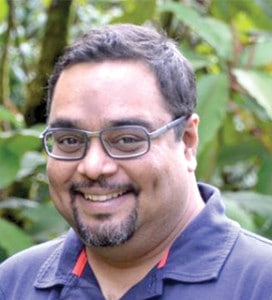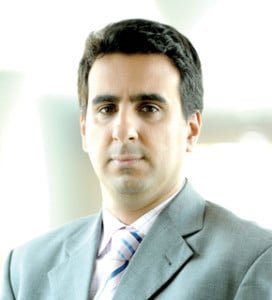
 The advent of new age technology has brought a pleothra of innovations in learning. Gone are the days when teachers and professors imparted knowledge to us with a chalk and a blackboard, it is the age of social learning. Some members of the educational sector share their views with Elets News Netwrok (ENN) on the swift learning through social media
The advent of new age technology has brought a pleothra of innovations in learning. Gone are the days when teachers and professors imparted knowledge to us with a chalk and a blackboard, it is the age of social learning. Some members of the educational sector share their views with Elets News Netwrok (ENN) on the swift learning through social media
he new era of technology has replaced these blackboard and chalk with a click of the mouse! Even though the digital learning is being experimented upon,what is fast gaining momentum is the social media networking platforms of Face-book, Twitter, Youtube, that are acting as research textbooks for the tech-savvy students.The concept of learning through the New Media and the conceptulisation of incorporating social media sites as partof learning in the students’ curriculum, for e.g., the Facebook is often seen as a suitable research engine for various groups, forums for engaging students in fruitful debates. But how far can we utilise this tool, as every explosion of information can be either utilised or exploited by the cyber criminals. To optimally use these platforms and thrive digital learning through social media,experts and gatekeepers of the sector are still hoping for best.
As per the McAfee’s Tweens, Teens & Technology Report 2014, a thorough survey across Indian online teenagers aged 8-12years old and 13-17 years old, comprising respondents from Mumbai, Delhi, Chennai, Bangalore, Hyderabad, Ahmedabad and Pune, there is a dangerous trend. Some 70 per cent of online youth in India spend more than five hours on the internet in a normal week. The Internet access is still predominantly desktop based (41 per cent), however, 36 per cent use laptops and 27 percent use smart phones among the Indian youth, these statistics only alarms the guardians and teachers to initiate necessary steps.

Necessary dosage of socialising
“Social learning enables a broader and new age approach to absorbing information. Through social media you’re able to educate yourself through new forms and with flexibility, while being able to share your reviews and opinions to benefit others. Social media acts as asocial facilitator to exchange informa-tion and expertise. I believe, social media has made it faster to absorb information and provides for a continuous learning environment,” says Zafar Rais, CEO,MindShift Interactive Pvt. Ltd.
India’s youth are constantly connect-ed, feels the McAfee’s report. Ined, feels the McAfee’s report. Interms of social networking terms of social networking platforms, Facebook is byplatforms, Facebook is byfar the most popular site used (93 per cent),followed by YouTube(87 per cent) and WhatsApp (79 percent). About 10-12years-old social ac-count users report higher count users report higher daily access to Snapchat,daily access to Snap chat, Pinterest, Tinder, Tumblr, and Pinterest, Tinder, Tumblr, and Vine than their teen counterparts, eventhough the minimum age to register to these social networking sites is 13 years.An eye opening trend is that half (52 percent) of India’s youth even access their social media accounts while at school;57 per cent being 8-12 years old v/s 47per cent 13-17 years-old.
Siddarth Bharwani, Director of Jetking, shares, “Social media has enabled us to communicate in ways that may have seemed unorthodox a decade ago.Today Wikipedia and YouTube are the most preferred resources for students who turn to the internet for information online. Jetking taps Facebook and Twitter for posting updates regarding upcoming events, opportunities for our students and highlighting their achievements. And we upload lectures by our faculty on YouTube for students to refer to again in case they miss something in class. We realise today’s students are the internet generation and social media definitely helps us in connecting with them. The key is moderation and them. The key is moderation and reaching out to them in a manner reaching out to them in a manner they are comfortable with.”
Bombarded with information

Education
more of research
children, youth and even adults engag Sumit Vohra, Founder, Education for All and Social Activistopines that the concept of the social media is booming in this social media is booming in this fast paced age of technology with fast paced age of technology with children, youth and even adults engaging and leaning onto the digital world for minute references.
“Children engaging themselves in social media is rampant. One of its causative factors being peer pressure the numerous in the cyber Zafar Rais Mind Shift Interactive the numerous in the cyberative factors being peer pressure but anything done under but anything done under supervised attention will supervised attention will reap no harm and will reap no harm and will ensure protection from ensure protection from the otherwise cyber the otherwise cyber threats that are looming in the cyberspace.threats that are looming in the cyberspace.The digital world has The digital world has access to voice ones access to voice one sopinions and thoughts to opinions and thoughts to world. The future of world. The future of digital learning Idigital learning I believe is the IB believe is the IB curriculum, which is widely accepted which is widely accepted abroad, where abroad, where students are students are required to do required to do more of research more of research work for their subjects.” Vohra added.work for their subjects.” Vohra added.
Youth often share what would be considered private information publicly,both intentionally and unintentionally.The report shows that despite majority (80 per cent) of Indian youth being aware that their online activity can affect their identity, out of 90 per cent who have done or posted something risky online, 70 per cent have posted their contact details like email, phone, home address.
“The acceptance however of children engaging on social media platforms is still lacking as they are bombarded with negative perceptions of this space.The learning however is that children are not guided properly into the world of the internet and therefore there is a gap between the needs of a parent and a child in the online world. With the internet community beginning to accept that children have different needs when it comes to social media, there ischange in content that is more responsible and beneficial to the child. Taking this first step in creating responsible content for kids in the online world not only enhances access to digital learning, but also ensures quality content for the child,” informs Monish Ghatalia, founder, worldoo.com.
Stark Reality of the VIRTUAL SPACE |
|
|
|
|
According to a study by Go-Globe, social networking accounts for 28 per cent of all media time spent online
“The way we engage on the internet has changed over the past few years. It is no longer just a highway of information,but has also become a source of entertainment, engagement with friends as well as a platform of work. When we are engaging with so many different things online, our children are also catching up with the content Ghatalia says.
According to a study by Go-Globe, so-cial networking accounts for 28 percent of all media time spent online. How can we then deny that social media has no benefits at all? Yes, for every activity that we send our child to, we ensure that they derive some learning experience from it.In the same way, when social media con-tent is directed towards children, it ensures that the amount of engagement is high and conversational in nature that can help the child come back to learn something more, adds Ghatalia.
However, a disturbing fact reveals that the youth are becoming moretrusting of the virtual world to familia-rise themselves with unknown people,in spite of being aware that it is risky.Some 63 per cent of youth do not turnoff their location or GPS services across apps, leaving their locations visible to strangers, and only 46 per cent enable their privacy settings on their social net-working profiles to protect their content.

For the better or worse?
Ghatalia speaks in favour of how social media has changed digital learning for the better.
“The rules of engagement with the online world have completely online world have completelychanged in today’s day and changed in today’s day and age. The internet has been accepted by both parents and teachers alike who have identified the crucial role that it plays in expanding the horizons of a child’s learning.”
Kids want to imitatewhat their parents and their what their parents and their peers do, so if there is a large number of comments on a particular topic,peers do, so if there is a large number of comments on a particular topic,they will also feel encouraged to join the discussion and share their opinion.This cross exchange of ideas may not bepossible in a classroom set up if a childis shy, but in the online world, a child would be able to express their ideas more freely that leads to learning, he adds.
RK Sharma, Director, Ahlcon PublicSchool, however feels, “The world of social media is very good for digital learn-ing, if used constructively, the platformwill be beneficial in holistic learning,apart from academics and can also garner behavioural aspect of the youth as well. Starting from the primary to the higher education it depends on the teacher on how they the teacher on how they impart the necessary and the correct knowledge impart the necessary and the correct knowledge on the students on the students that will progress that will progress the learning in the learning in them.”

Optimum research tool
Apart from interaction,Apart from interaction,these networking sites have these networking sites have gained popularity because of its social method of attaining necessary research,while engaging people and so on.
Kalpesh Banker, Founder and Man-aging Partner, EduShine Advisory Group, feels, “Digital is certainly a ma-jor part in learning in terms of socialmedia, it is the future as independent fo-rums provide a platform for the students to interact likewise.”
“A curated social network can be created, gap in personal and learning oriented is the drawback in terms of adoption for the university or higher education sector, their administration is apprehensive in the adoption process.Students use Kora, Youtube for learning generally and social media. My probability is higher and my learning is higher than my classmate. My classmate will contribute equally then social media can contribute optimally. Groups of research like the Gate research and academia are gaining popularity among the students because it is the new generation learning and is considered as the mandatory thing for research among the students.One cannot stop the coming generation in utilising the social media as it has penetrated the current generations ’mindset,” he says.
But, keeping tab on the numerous sites is also essential. “They need guidance for sure, for social media networks like Facebook, cyber crime is prevalent with cases of hacking and all. These predominant issues should be made aware for the students as they lure you into the web world easily,” Says Banker.
As per the McAfee’s report, despite significant efforts to discourage cyber bullying, and its negative effects, two-thirds (66 per cent) of youth in India have had some experience with cyber bullying.

Sea of change
Even though the con-Even though the concept is gaining momentum, it still has scope of change while adapting to the nuances of new-age learning.
Institutions, says, “Both Nitin Putcha,CEO, ITM Group of Institutions, says, “Both social media and digital social media and digital learning are in a state of volatile change.Nitin Putcha CEO, ITM Group of Institutions
The explosion of social networking findsa parallel in the spread of Massive Open Online Course (MOOCs). Digital learning today is essentially an online socialactivity, with learners joining communi-ties and studying together, unhampered by distance or time. As social media changes, from broad-based networksand unfiltered social sharing to per-haps the resurgence of verticalhaps the resurgence of vertical networks and micro-local networks and micro-local networks, so will digital learning- MOOCs areoverhyped and under-whelming as a learning technology, and stand to make way for emerging social emerging social learning plat-forms, which learning plat-forms, whichforms, which may combinemay combinemay combine mobile technology,mobile technology,mobile technology,peer-to-peer learning,peer-to-peer learning,virtual presence and focused learner communities. So, social media and virtual presence and focused learner communities. So, social media and Nitin Putcha CEO, ITM Group of Institutions digital learning are inter-twined, and someday may be a digital learning are inter-twined, and someday may be a single platform.”single platform.”

Opines Rahul Puri, Head-Academics, Whistling Woods International, “Social media has Whistling Woods International, “Social media has become part of life and become part of life and therefore it has not therefore it has not only found its way only found its way into curriculum and into curriculum and syllabi but also into syllabi but also into learning.”learning.”
Students can get instantaneous feed-back on ideas and gain instantaneous feed-back on ideas and gain access to wider reaching access to wider reaching markets across the world. This markets across the world. This allows a wide range of learning opportunities that teachers can develop which are practical and have real world results,says Puri.
“It’s here to stay and we use it extensively in our teaching and practical’s at Whistling Woods and will continue to develop these techniques,” he added.






















